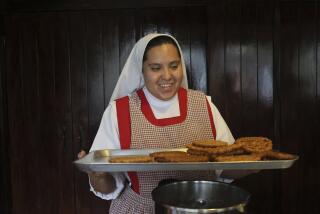EUROPE : Bosnian Town Draws Heavenly Profits
- Share via
MEDJUGORJE, Bosnia-Herzegovina — After 3 1/2 years of war scared away all but the most determined pilgrims, the miracle of religious commerce has returned to this Roman Catholic village where the Virgin Mary is said to make daily appearances.
Johnnie Walker flows at the Santa Fe Bar. Kathy’s Kitchen is serving up tuna salad and Guinness beer. Charlie’s So Good So Fast is offering burgers and fries to go. The dizzying array of earthly temptations includes such keepsakes as diamond rings, Swiss watches, gold pendants.
“It wasn’t this good even before the war,” said Drazena Maric, who runs the bustling La Paloma trinket shop, one of many businesses cashing in on last year’s Dayton, Ohio, peace accord. “And everyone seems to be interested in buying.”
It was 15 years ago that six youths say they saw the Virgin Mary floating on a cloud above a rocky hilltop overlooking this tiny village.
The sighting became a sensation, drawing pilgrims from around the world. By the late 1980s, about 2 million people a year scaled the jagged slopes of Mt. Podbrdo--many on bloodied knees--in search of the blessed mother.
But the goings-on of Medjugorje have never been purely spiritual. In the early days, authorities in Communist Yugoslavia imprisoned a local priest who vigorously promoted the apparition, insisting he was behind a ploy by Croat nationalists to undermine the regime by whipping up Catholic hysteria.
It wasn’t long before the main village road was reborn as a thriving strip mall. The ubiquitous flocks of sheep soon gave way to processions of air-conditioned coaches, as villagers forsook work in the fields to tend to the needs--and pocketbooks--of visitors.
“People became lazy and got used to having easy money,” said Davor Ljubic, owner of Globtour, one of the largest travel agencies in town. “In a sense, the war came at the right time because people learned to work again and not expect life to always come so easy.”
But this year, the fields are emptying again as the cash registers’ ring records the pilgrims’ greatest showing since 1989. With both communism and the war gone, Ljubic and others are getting ideas about making Medjugorje an even better attraction.
Ljubic helped bring Spanish tenor Jose Carreras to town last month for the grandest extravaganza here in years; some residents want to incorporate Medjugorje to keep authorities in Citluk from siphoning off proceeds from such events. Not surprisingly, Citluk’s mayor will not hear of it.
There is also talk of a new bed tax--to pave and widen crumbling roads, clearing the way for even more visitors. And though still hush-hush, another business opportunity is emerging: less-devout visitors interested in touring nearby war-ravaged Mostar and other battlefields.
In a sign of the problems, Croatian President Franjo Tudjman, who has called Medjugorje the spiritual source of Croatia’s national revival, caused an uproar when he flew by helicopter to Medjugorje to attend the Mass sung by Carreras.
Some Bosnian Muslims accused Tudjman of meddling in the internal affairs of their country by appearing as the de facto leader of Bosnian Croat-controlled territory, where the kuna already serves as the official currency and Croatian flags are common.
More to Read
Sign up for The Wild
We’ll help you find the best places to hike, bike and run, as well as the perfect silent spots for meditation and yoga.
You may occasionally receive promotional content from the Los Angeles Times.






